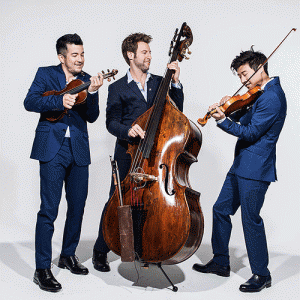Time for Three resumes contact with Indianapolis Symphony as Classical Series debuts
From the stage of Hilbert Circle Theatre Friday night, two of the three founding members of the "garage-
 |
| Nick Kendall, Ranaan Meyer and Charles Yang make up Time for Three. |
band string trio" known as Time for Three heaped praise on Indianapolis' contribution to their development as an ensemble during the decade they spent here as ensemble in residence for the Indianapolis Symphony Orchestra.
Ranaan Meyer, who plays double bass superbly, even credited the ISO and local audiences with deserving some of the glory shed by Tf3's Grammy win this year. Mutual admiration was indeed well-distributed as the guest artists played one of the recent concertos written for them and commissioning orchestras: "Contact" by Kevin Puts.
In four movements, with alliteration running through its titles, "Contact" made a hit with the first of two audiences Time for Three is entertaining here this weekend. A repeat performance of the program, which also includes Prokofiev's Fifth Symphony and Beethoven's "Egmont" Overture, will be at 5:30 p.m. today. Kevin John Edusei, a popular guest conductor touted by some as a worthy successor to Krzysztof Urbanski as ISO music director, is on the podium.
"Contact" exploits the technical skills and textural variety that Meyer and violinists Charles Yang and Nicolas Kendall are capable of. The composer shows sensitivity to the wealth of arrangements and fresh compositions in Tf3's discography; he knows their stuff, seemingly as well as they do.
There is also wordless singing, which opens "The Call" (first movement) and sets the work's exploratory tone. On Friday, the ensemble displayed just as much rapport and accuracy vocally as it does when its string instruments are in force. That's when ringing pizzicatos, well-balanced counterpoint, and heart-stirring melodies come into play, all informing Puts' inspiration from what he heard Tf3 do at a New York pub before making professional contact — and hence, "Contact."
The control exhibited at low dynamic levels, sometimes with sensitively applied non vibrato playing, was exemplary in the title movement. Fantastic exuberance, with lots of rapid string crossings from the violins, dominated the finale, "Convivium." The second-movement scherzo, "Codes," was both funny and ferocious.
For an encore, Time for Three brought back an old chestnut, its arrangement of Leonard Cohen's song "Hallelujah." I'm amazed at how firmly this tune has lodged in the public ear, reminding me of another infectious ear-worm with a narrow melodic range, Stephen Sondheim's "Send In the Clowns." Tf3's sensitive performance Friday was dedicated to the memory of Marianne Williams Tobias, longtime program annotator for the ISO, who died in July. (Before the music began, ISO CEO James Johnson dedicated the 2023-24 Classical Series to her.)
The audience hung on every note the beloved ensemble played. Attentiveness seemed to be constant. Interaction with the orchestra and the soloists' body language made the performance a visual treat as well. Also stunning were the white tennis shoes the violinists wore, especially Kendall's. My imagination hurtled backward before my concert-going time: If Jascha Heifetz had rocked footwear like that in his heyday, perhaps the critic Virgil Thomson would not have panned a 1940 recital by the Russian superstar as "silk underwear music."
The concert opened with a trim, vigorous performance of Beethoven's "Egmont" Overture, which moves from somberness and tumult onto a plane of triumph. That concluding plateau amounted to nice set-up for the increasingly triumphant, we-knew-them-when Time for Three.
But that's not all, one might add to echo the the hype of late-night TV commercials. After intermission came the Prokofiev, whose triumph from its Soviet premiere through its introduction to the Western world is a matter of record. It's possible to find the climax and conclusion of the first movement too loud (as I did in this orchestra's last performance in 2018) and still acknowledge how it's a logical way to end the weighty Andante, which could hardly make sense if Prokofiev had chosen restraint.
Edusei made sure the orchestra didn't get bogged down in the heaviness, thanks to how the long lines flowed and the manner in which the brass were nicely poised against the strings, instead of sounding merely massive. The second movement was charming in the delicacy of its rapid, wispy figures and the well-balanced warmth of the winds in the trio sections.
The solemn march character of the Adagio was richly displayed. The tensely begun but uplifting finale remained unfailingly effervescent, with a wealth of color in which the percussion section splendidly capped its frequent employment in the work. In this performance, the final measures dependably reflected the composer at his cleverest. It would take a lot of repeat hearings for that denouement to seem tiresome. On Friday it was equally stimulating to what Time for Three had provided in the unique triple concerto that showcased it so well.



Comments
Post a Comment